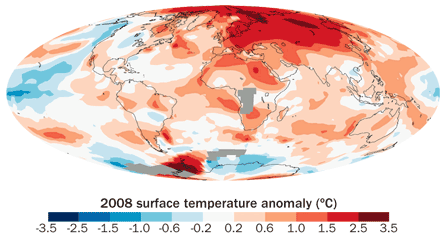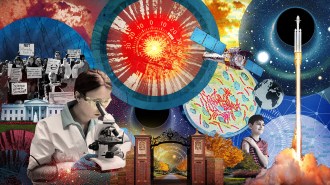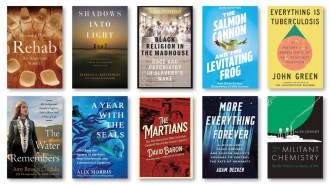90th Anniversary Issue: 1990s
Detecting climate change and other highlights, 1990–99

Climate in flux
More than half a century ago, temperature records from Antarctica and the Arctic showed data “consistent with the theory that the entire world is slowly getting warmer,” Science News Letter reported. This low-grade fever began around 1900 and was believed “to amount to some two or three degrees each century” (2/28/59, p. 131). But not until the 1990s would climate experts from around the world begin issuing consensus statements through the Intergovernmental Panel on Climate Change warning of catastrophic climate perturbations if humankind didn’t put the brakes on releases of carbon dioxide and other greenhouse gases (6/23/90, p. 391) — preferably immediately (11/4/95, p. 293). As international agreements such as the 1997 Kyoto Protocol have largely failed in that task, scientists have expanded efforts to chronicle the world’s shifting climate (above, 2008 temperatures compared with 1950–1980 baseline period) and ecosystems (SN Online: 12/2/11). — Janet RaloffNote: N indicates findings that went on to win a Nobel Prize.
1990 | Hubble NASA launches the Hubble Space Telescope (1/6/90, p. 8; 5/5/90, p. 276; 6/30/90, p. 407).
1991 | H. pylori A series of research efforts compellingly link stomach ulcers to the H. pylori bacterium (12/14/91, p. 399). N
1992 | Big Bang signature Cosmologists detect temperature fluctuations in the cosmic microwave background, variations that correspond to ripples in the density of matter shortly after the Big Bang (5/2/92, p. 292; 12/19-26/92, p. 420). N
1992 | New brain cells Neuroscientists discover that a protein can prompt mature nerve cells in adult mice to divide, dispelling the belief that adult mammals’ brain cells cannot reproduce (4/4/92, p. 212).
1993 | Dark Milky Way Astronomers report evidence of Massive Compact Halo Objects at the outskirts of the Milky Way (9/25/93, p. 199). These MACHOs account for part of the universe’s missing mass.
1993 | Human cloning Scientists for the first time clone human embryos, raising a host of ethical questions (10/30/93, p. 276).
1994 | Black hole Astronomers report the most compelling evidence for the existence of a black hole at the center of galaxy M87, 50 million light-years from Earth (6/4/94, p. 356).
1994 | Breast cancer genes A pair of genes, BRCA1 and BRCA2, appear to play a role in some inherited breast cancers (9/24/94, p. 197; 12/3/94, p. 372).
1995 | Climate changing The Intergovernmental Panel on Climate Change finds evidence of a discernible human influence on climate (11/4/95, p. 293).
1996 | Oldest life Carbon isotope measurements from Greenland rocks push back the history of life on Earth to 3.85 billion years ago (11/9/96, p. 292).
1996 | Dolly the Sheep A sheep named Dolly becomes the first mammal cloned from the DNA of an adult animal (3/1/97, p. 132; 4/5/97, p. 214; 10/20/01, p. 250).
1997 | Stem cells Biologists isolate human embryonic stem cells, which have the potential to become nerves, blood or any other tissue (7/19/97, p. 36).
1997 | Quantum teleport Researchers harness quirks of quantum behavior to transfer one photon’s polarization state to a remote photon (1/17/98, p. 41).
1998 | Speedier universe Astronomers uncover data indicating that the expansion of the universe is picking up speed (3/21/98, p. 185; 10/31/98, p. 277). N
1999 | HIV source Genetic studies confirm that the AIDS virus originated in chimps living in central Africa (2/6/99, p. 84).
1999 | Cancer drug Researchers report on a new drug, eventually trade named Gleevec, that shows promise in specifically targeting chronic myelogenous leukemia cells (12/11/99, p. 372).







